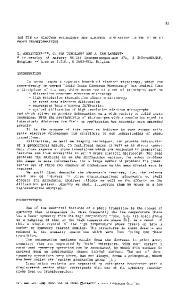Synchrotron Source X-Ray Diffraction Used to Study Phase Transformations in Steel
- PDF / 128,681 Bytes
- 2 Pages / 612 x 792 pts (letter) Page_size
- 8 Downloads / 296 Views
As reported in the October 21 issue of Physical Review Letters, the researchers in cooperation with I. Sharkov from St. Petersburg State University, Russia, and B. Farago from Institut Laue-Langevin, France, realized the inside-detector concept for neutron holography imaging of lead nuclei in a Pb(Cd) single crystal. The researchers used a spherical-shaped single crystal of Pb 0.9974 Cd 0.0026 for this experiment. It is known that the Cd absorption cross section for thermal neutrons is more than four orders of magnitude larger than for Pb, thus Cd atoms could act as highly efficient detectors. Due to the low concentration of Cd, these atoms are randomly distributed on regular lattice sites and any one Cd atom is surrounded by Pb atoms. The lead nuclei play the role of the object while the cadmium nuclei serve as pointlike detectors inside the sample by emitting gamma rays that are detected outside the crystal. The researchers registered the gammaray image and reconstructed the atomic structure by use of a computer conversion of a hologram to a three-dimensional picture. Furthermore, the researchers restored the object without making use of any a priori knowledge about the orientation of the sample. The researchers said that their results demonstrate the feasibility of atomicresolution neutron holography as it was originally proposed, so the practical applications appear highly promising. They said that the special properties of the nuclear scattering process of neutrons, including its isotopic sensitivity and its dependence on the magnetic moment, will substantially enlarge the field of investigation opened by this technique. ANDREI A. ELISEEV
Coherent X-Ray Technique Reveals Interface Structure with Sub-Angstrom Resolution Several nondestructive methods are available to study the structure of epitaxial films and interfaces, but interpretation of the results depends on the mathematical model applied, which sometimes produces incorrect conclusions. As reported in the October issue of Nature Materials, a group of researchers have developed an x-ray method, called coherent Bragg rod analysis (COBRA), for the direct determination of epitaxial structures. Analyzing the coherent Bragg rods, Yizhak Yacoby and Mukhles Sowwan of Hebrew University, Israel, and their co-workers at the University of Washington, Seattle; Argonne National Laboratory, Illinois; Brookhaven National Laboratory, New York; and the University of Michigan, Ann Arbor, were 6
able to map with atomic precision the structure of the interfacial region of a Gd2O3 film (2.7 nm thick) grown epitaxially on a (100)GaAs substrate. A synchrotron beam line at the Advanced Photon Source was used for observing the diffraction pattern and the sharp Bragg peaks were detected together with the scattered intensity between peaks. COBRA, the technique used in this work, consists of analysis of intensity along the line between any two peaks in reciprocal space. The scattered intensity characterizes the two-dimensional periodic regions such as the substrate truncation, the
Data Loading...










